Abstract
This article addresses the application of building-integrated photovoltaic (BIPV) systems through the analysis of a case study with different operating conditions and geospatial locations. The research is carried out with customer-made photovoltaic modules supported by computational aids. The results obtained from real-life BIPV installation are contrasted, simulated, and improved through different scenarios where aspects such as software deviation, shadowing influence, installed capacity, and project profitability are analyzed to establish viability pathways for BIPV projects. As a result, the most relevant factors to improve the technical and economic conditions of the BIPV system are the total capacity installed, the use of the available area, and the strategic location of the modules to avoid shading surfaces. In this way, this work addresses the analysis of BIPV systems through the assessment of a case study implemented in a real residential structure in Colombia. The proposed methodology includes simulations to evaluate the solar energy potential considering the elements in the neighborhood of the BIPV system and technical aspects, such as the wiring and power interface, an economical study to find the feasibility of the project, and an analysis of different operating scenarios. As a result, the most important factors that affect the operation of BIPV systems under Colombian weather conditions were identified: total installed capacity, use of the available area, and strategic location of the modules to avoid shading surfaces. Such factors can then be considered in the early stage of designing for future BIPV applications.
1. Introduction
Buildings consume at least 40% of global energy and are responsible for 36% of all CO emissions and 28% of greenhouse emissions [1,2]. Therefore, it is necessary to develop strategies to achieve the different goals of energy savings and mitigating global warming. Renewable energy sources have become a competitive option to face the current energy and environmental challenges. In particular, photovoltaic (PV) technology has become increasingly popular due to improvements in recent years. Consequently, the levelized cost of electricity (LCOE) of new PV projects at the utility-scale fell 13% in 2021 [3]. In addition, governments promoted incentives for renewable energy, demonstrating more interest in PV technologies. In recent years, worldwide solar energy has maintained a constant and exponential growth trend [4]. The evolution of the global installed capacity and annual additions over the last 12 years was described in [5], where China, the USA ,and Europe have taken advantage of this rising tendency. However, in 2020, the trend changed due to the global crisis, and the distributed PV additions dropped slightly. The total cumulative installed capacity for PV at the end of 2020 reached at least 760.4 GW [6]. Annual solar PV additions globally are expected to accelerate during 2023–2025, due to faster recovery of distributed PV applications as the global economy improves.
PV systems in buildings are widely used since rooftops and ceilings provide a suitable location to place PV panels. Such installations correspond to the BAPV (Building Applied PV Systems) concept. However, they are not the only way of using PV generation in buildings. BIPV (Building Integrated PV System) is an option to produce energy while meeting architectural limitations, taking advantage of facades and fenestration [7]. Moreover, shading devices and decorative components can be used for this purpose. Different types of solar cells are commonly used for BIPV and BAPV, among them: polycrystalline, monocrystalline, amorphous, and thin films on a foreign substrate. Thin film (TF) solar cells, in particular, use amorphous silicon (a-Si), cadmium telluride (CdTe), copper indium sulfide (CIS), and copper indium gallium diselenide (CIGS) and have the advantage that the semiconducting material is deposited on a substrate [8]. In BIPV applications, photovoltaic modules are integrated into the surface of the building envelope because of their features (size, flexibility, shape, and appearance). These photovoltaic elements can be used together with common materials in architecture, such as glass or metal, in opaque as well as semitransparent surfaces [9].
Worldwide, the BIPV market has significant energy potential. However, there is an established market in most European countries,, such as Germany, Spain, France, Switzerland, and Italy. In these countries, approximately of the BIPV installation is on facades, and the remaining is on rooftops [10]. BIPV’s worldwide growth rate over the past seven years is approximately of installed capacity in each year [11]. For other regions, such as China and Japan, the increase in investments will be slower but will still represent attractive markets [12]. Despite the many advantages of BIPV technology for the building and its occupants, the implementation of such technologies is not widely used in certain countries. This is the case in Colombia, where the weather conditions are favorable for photovoltaic generation due to the good radiation levels throughout the year. More than half of the country has an average solar irradiation of 194 W/m and an average solar radiation of kWh/m/d. These values exceed the global value of kWh/m/d of solar radiation [13]. However, BIPV applications in Colombia are not widely implemented or studied. Moreover, there is no official record of studies that present a technical and economic analysis of BIPV system installation. Recently, some policies have been promoting renewable energy projects, which will soon increase interest in BIPVs. For example, Law 1715 proposes four incentives for investment in renewable energy projects: exclusion of income tax, VAT exemption on services and equipment, elimination of tariffs, and accelerated depreciation of assets [14].
Design and analysis of the performance of BIPV systems have been studied from different points of view: installed capacity, available area, investment fund, PV materials and products, planning, study cases performances, and resilient infrastructure, among others. The work presented in [2] introduced an approach to the design of prefabricated BIPV walls for tall buildings. The approach allows obtaining a type of prefabricated opaque multi-layered BIPV wall. Advantages such as reduced safety risks associated with working at height on-site, high-performance electricity production, fast construction, and low cost are obtained. In this way, this approach enables quick and simple installation of PV modules, as well as their wall structure and wiring. In [15]. the authors studied the replacement of conventional glass used in PV modules with a polymer material to improve optoelectronic performance and reduce total weight and cost. The innovative concept consists of the conversion of photon energy in the UV and blue range to wavelengths near the red and infrared areas. The proposed downshift photon converter permits the conversion of high-energy photons to lower energies, where silicon cells have a better spectral response. In [16], the design of a BIPV system with a reflector PV System and its control was introduced. Considering that BIPV systems are expensive and their efficiency is lower compared to a conventional roof-mounted photovoltaic system, the authors proposed increasing incident light on PV modules by using a planar-shaped reflector. In this way, the sunlight flux intensity per unit area on the BIPV increases, which results in an amplified output power, allowing a decrease in the size and cost of the PV modules. Moreover, the authors also proposed an algorithm to control the de-reflector PV system. The authors in [17] presented a tool to plan and design BIPV systems. Such a tool allows sizing the system in the early design stage, including the storage system. Furthermore, the tool is capable of calculating the capacity and position of the PV panels to be installed on the envelope of a building using optimization methods. The user must provide information such as geometry, surrounding structures, weather, and energy demand, among others. Digital technologies can be applied to BIPV systems, as is the case in the research presented in [18], where the use of artificial intelligence, the Internet of Things, and robotics for BIPV performance improvement is studied; some issues related to the operation of BIPV systems, such as the increase in the temperature of the PV panels, the dust on the surface of the panels, and different types of faults are discussed. Works presented in [1,2,19] discussed study cases located in Asia which cover different aspects such as barriers, policies, opportunities, and challenges, while study cases of [20,21,22] addressed the performance of building integrated PV/thermal (BIPVT) systems which is also an interesting option to exploit the structure of buildings.
On the other hand, with the effect of industrial migration on digitalization, simulation studies are the best tools to estimate the technical and economic performance of BIPV systems since they can optimize the project design by maximizing the irradiation received through orientation and evaluating the impact of shading on the systems. In this way, Robinson and Sone [23], proposed a predictive method for solar radiation data, available as GenCumulativeSky, which takes a weather file as an input and generates a solar distribution in the sky. It can be described as a global radiation distribution for a discretized sky vault or a discrete diffuse radiation distribution with a subset of statistical or sun hours and produces annual irradiance images from a single simulation. The method successfully combines the advantages of the alternative approaches represented by computational efficiency and accuracy. This approach has found particular application in estimating accurate annual solar irradiance at the building structure and its surroundings. It helps identify areas with potential for PV and sites with excessive solar exposure (overheating) that should consider shading options to reduce solar penetration. Another accurate method to predict PV potential through surface irradiance is the rendering method used in Autodesk Green Building Studio. This method is validated at the National Renewable Energy Laboratory (NREL), according to the standard calculation methods for irradiance [24]. Both methods present valuable tools for estimating BIPV potential that can compete with tools designed only for conventional PV systems while effectively and accurately representing complex shading and environments [25]. The authors in [26] described an empirical validation of the EnergyPlus simulation tool for a double-skin facade (DSF) performance simulation. A series of experiments were conducted for cavity airflow and thermal behavior of the DSF and then compared with simulation outputs. It also shows significant differences in the thermal and airflow behavior of DSFs between the measurements and simulation predictions by EnergyPlus. Another example is presented in [27], where a dynamic simulation, energy, and economic analysis of BIPV and BIPVT collectors were developed in TRNSYS. Both systems were coupled with small-sized wind turbines (WTs) to reduce the fluctuations of power production typical of solar systems. In [28], solar design tools which are used to analyze BIPV systems were directly compared. However, the tools studied can analyze these types of projects partially because not all of them consider the variety of factors that might directly affect the efficiency of a BIPV project. Some tools combine CAD design or consider techno-economic analysis, their results approaching real-case scenarios. This work was used as a base material for the report presented in [29] in which a compilation of the most relevant aspects oriented to the design, planning, and management of BIPV systems were presented. The authors identified 15 key factors which were widely discussed. The report can be considered a valuable tool for understanding the potential and limitations of BIPV. Moreover, it provides useful information for software tools oriented to BIPV systems.
From the literature review, the authors identified interesting aspects such as: lack of clear procedures for the design of BIPV systems due to the particular structural conditions of buildings and the need for information concerning the manipulation of PV devices for their use in BIPV systems. Considering the weather conditions in Colombia, it is important to study all possible applications of photovoltaics, such as BIPV systems. Taking into account the aspects discussed above, this paper addresses the problem of design, simulation, and economic analysis of a BIPV system located in Colombia. The system was implemented in a real residential structure which allowed contrasting the results of produced energy with simulations. A 90 axis rotation was also considered in the simulation in order to analyze a different radiation profile and its impact on the BIPV system performance as well as geospatial parameters. The main contributions of the study are:
- A detailed description of the design of the PV components used in the BIPV system which can be adopted in other cases.
- An assesment procedure to define the technical and economic feasibility of the BIPV system.
- An analysis of the factors to consider in the early stage of design that can increase the potential of BIPV systems under different operating conditions.
This paper is organized as follows. Section 2 describes the methodology proposed in this work. Section 3 presents the BIPV experimental validation using a real case scenario and also presents the PVSITES deviation of the software comparing the experimental and simulation results. Then, Section 4 presents some simulations of the study cases to evaluate the installed capacity of BIPV and BAPV, as well as the payback times of the projects. Finally, the conclusions and future work are discussed in Section 6.
2. Methodology
This research is based on the analysis of a BIPV system installed in the city of Medellin, Colombia [30]. The system sizing was carried out based on the available area in the front part of the building (windows). Based on this information, custom solar panels were designed, assembled, and installed in order to evaluate the profitability of the system. Subsequently, the power interface was selected, which is necessary for its connection to the grid and the loads.
It is necessary to clarify that this sizing did not consider some technical aspects, such as incident irradiation and partial shading caused by nearby buildings, nor was an economic analysis carried out that would allow evaluation of the project profitability. In this way, the analysis of the system was carried out through a simulation tool that allows technical and economic evaluation. This analysis is required in the design stage to evaluate the best location of the BIPV system and the adequate area as well as the type of PV technology that best suits the project under analysis, all in order to provide a solution to specific energy demand and to achieve a positive result from an economic perspective.
The proposed methodology for analyzing the case study is presented in Figure 1. In the first stage, the case study is evaluated through information such as the type of building, the area available on the facade and on the roof, energy consumption, and the cost of energy, as well as all the technical and economic information of the BIPV assembly. All this information is presented in detail in Section 3.1.
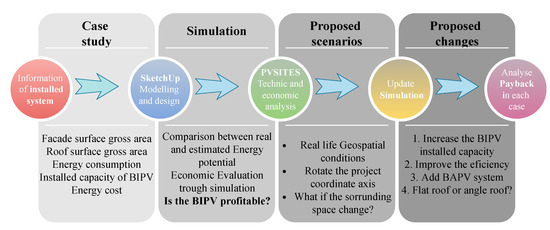
Figure 1.
Methodology of study.
Stage 2 requires the use of computational tools for the evaluation of the project. This is a step that should have been carried out in the initial stage of the project, but in the case study it was not carried out, which did not allow for considering the effect of partial shading on the energy production of the proposed BIPV system. To achieve this, the steps proposed in Figure 2 must be followed.
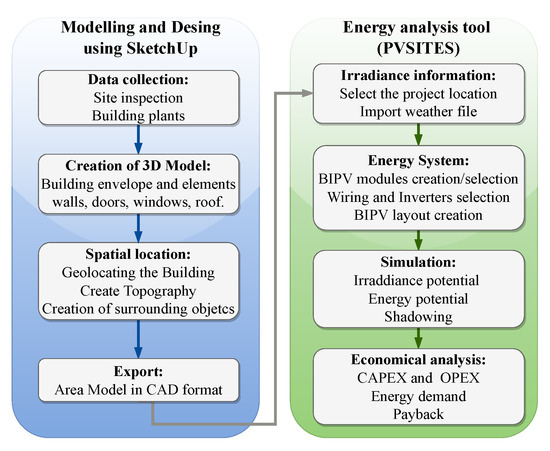
Figure 2.
Methodology of simulation.
Initially, it is necessary to perform an inspection of the selected area to carry out the assembly, type of building, number of floors, and area, among others. Then, the 3D model is generated for which it is necessary to include information on the building envelope that includes walls, windows, and roofs. However, this information is not enough, since the entire nearby area must be included in the 3D design in order to have the most detailed information possible. In this project, all nearby buildings were created and located around the case study. Finally, it must be exported in a CAD format to the simulation tool for the analysis of BIPV systems. Some inputs of the simulation tool include the location of the project and weather profile information for the specified location. In addition, it is required to create or select the photovoltaic modules that will form the BIPV system and connect the system to the grid and loads. The information on the simulation stage is presented in Section 3.2 and Section 3.3.
The simulation tool allows the evaluation of the return of investment of the project and allows the establishment of the project viability. This analysis is presented in Section 3.4 and shows how the recovery of the investment is made in a time greater than 40 years, a time in which the useful life of the equipment has expired and must be replaced at least once.
As mentioned earlier, and in order to present how aspects, such as geographical location, the angle of solar incidence, and the surrounding area, affect the energy production of the project, some modifications are proposed in the initial project, considering a scenario in which the project has not yet been installed which allows making decisions, such as: rotate the geospatial location, fewer nearby elements, or the possibility of modifying the slope of the PV modules so that a large amount of radiation could be received. This information is presented in Section 3.5.
The final stage considers evaluating some modifications for each scenario, such as the increase in installed capacity of the BIPV, the increase in efficiency of the system through the selection of photovoltaic panels with higher energy production, the use of the roof area to include an additional BAPV system, and also the incidence of the inclination of the BAPV system in energy production. The description of these modifications is presented in Section 4.1. All the results produced by PVSITES for each scenario and each case are presented in Section 4.
Finally, each case is compared in each scenario through its cost, installed capacity, and payback in years, allowing for a decision scenario that involves technical and economic information.
3. Customized PV Modules Software Analysis
3.1. Case Study
Martinez et al. developed an experimental BIPV assembly of custom-made PV cells for the windows of a household in Medellin, Colombia [30]. The steps of panel manufacturing are explained in detail below (see Figure 3).
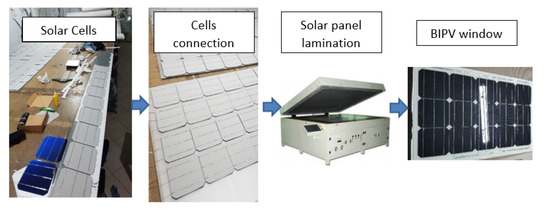
Figure 3.
Manufacturing of solar panels.
After the manufacturing process, the solar system was installed on the windows of a suburban residence in Medellin. Figure 4a,b show the view of the house before and after the installation of the BIPV system. The solar system is made up of 8 panels and has a capacity of 400 Wp in an area of 7 m × m. The electrical integration of the solar system with the building’s grid was achieved through a micro-inverter (WVC 300–230 VAC). The micro-inverter allowed the recording of hourly energy generation data.
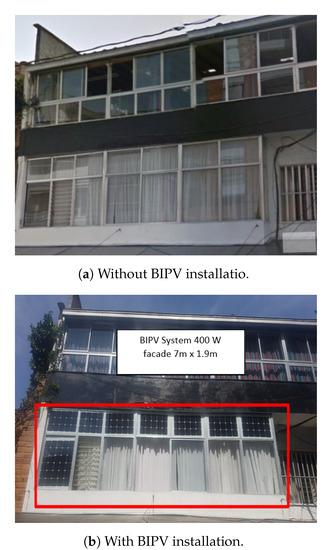
Figure 4.
Households’s front view.
In the designing stage, there was no considered variation of incident irradiation through the year that directly affects the amount of BIPV power output. An economic evaluation was not performed to verify the feasibility of the project. The results obtained by simulating the BIPV system through the PVSITES tool will be presented below. This is in order to estimate the annual energy production of the installed system considering the effects on the irradiation of the BIPV system and the payback in years. As input parameters of the simulation tool, all information from the building and the surrounding elements described in Figure 2 in a 3D model is required, as well as all information from the BIPV system described in Section 3.4. In addition, solar irradiation profiles were required. As output parameters, the software tool delivers the annual irradiation potential in the BIPV system installation area, the annual energy potential, and the payback, among others. Based on the analysis of the technical and economic results obtained, some modifications in the BIPV system that will improve not only the technical results of the project but also the economic ones will be presented.
3.2. Case Study Simulation
To include constructive information about the case study and the surrounding buildings and elements, PVSITES software was used. This tool integrates CAD and BIM features and offers an extensive database that includes BIPV products and irradiation. It is user-friendly and allows the prediction of the performance of BIPV systems and their energy impact on the building. The European Commission also supports this tool to promote its Net Zero Energy Buildings (NZEB) objective [31].
A 3D design of the house was made as detailed as possible in the SketchUp platform, including nearby buildings, to seek an accurate assessment of the shading effect on the system because the design and energy performance of BIPV systems are strongly linked to the surroundings where the BIPV modules are integrated. Figure 5 presents the architectural design of the block where the BIPV system is located.
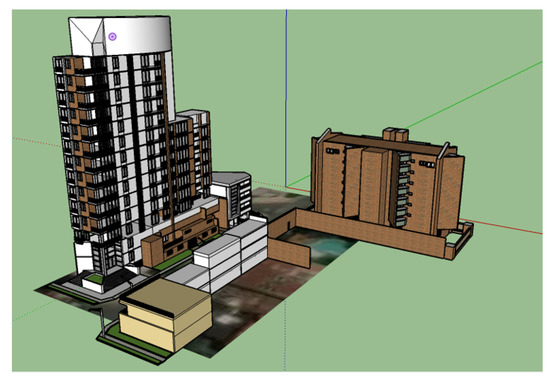
Figure 5.
Case study SketchUp design.
The 3D architectural design was the first input for the software simulation. Subsequently, the georeferencing was parameterized with the project’s location, Medellin (Colombia), and the meteorological climate file was loaded from the program’s database. In addition, PVSITES has the Heliodon tool, which is used to simulate the sun’s trajectory on the celestial vault showing the position of the sun at the selected time of the day [32]. This allows evaluating the impact of the shading incident on the proposed BIPV system. Figure 6a,b present the 3D design integrated with the software.
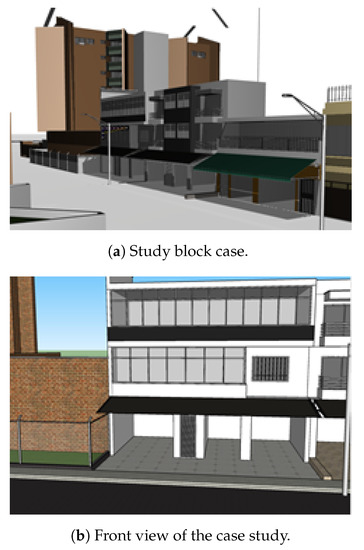
Figure 6.
SketchUp design.
3.3. Irradiance on the Window Surfaces
The first result of the software was obtained after providing the geographic and climatic data. PVSITES provides qualitative and quantitative data of the annual average irradiance value (kWh/m) for all surfaces in 3D scenes. This value allows the evaluation of the solar energy potential in each area. Figure 7 shows the irradiance on the facade surface, where the solar windows will be integrated. Color profiles help to visualize the average irradiance ranges, where the darkest corresponds to the minimum (Black—0 Wh/m) and the lightest to the maximum (White—590 Wh/m). On average, the irradiance of solar windows is 187 Wh/m, which is lower than the average irradiance (4410 Wh/m/d) of a roof without shading in Medellin [13]. This result identifies the strong decrease of irradiation in the perpendicular surface on the horizontal (less exposure to the direct rays of the sun), and it is also affected by the shadows of nearby buildings.
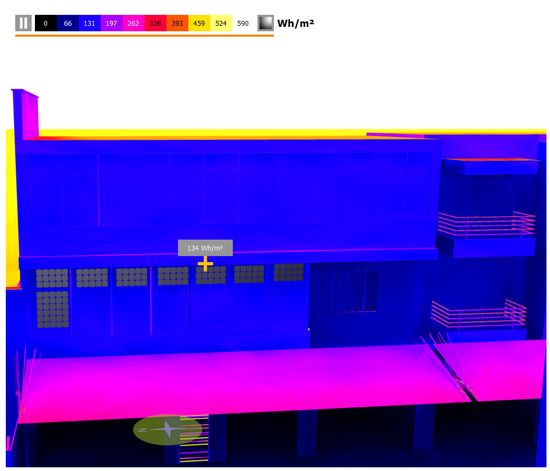
Figure 7.
Irradiance on the facade surface.
The software has an extensive library of commercial BIPV products, with technical characteristics determined by the manufacturer. In this case, monocrystalline panels with an average yield of W/m were included. These data were obtained from a proprietary panel design, not from commercial sources. The primary purpose of a proprietary design is to take advantage of the maximum useful area available for solar windows. Figure 8 shows the integration of the modules in the building facade.
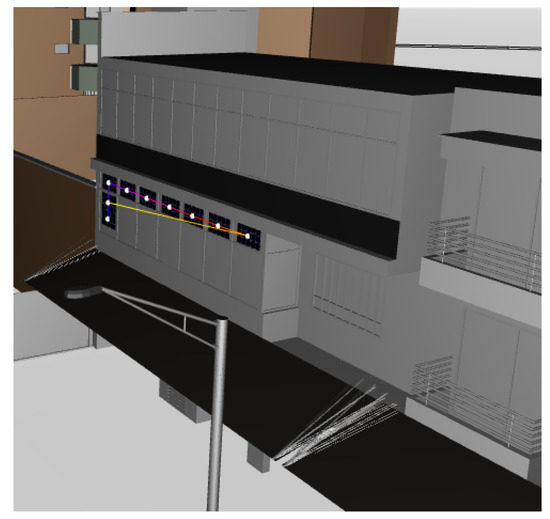
Figure 8.
Integration of the modules in the facade.
Once the BIPV system is configured at the desired location in the 3D model, the next step is to select the inverter. The software allows the selection of different configurations for the installation, and it has the option to include custom configurations. For the case study, a 600 W Soladin inverter with a Maximum Power Point Tracker (MPPT) was selected.
Subsequently, the wiring of the BIPV system was carried out, which is an important aspect in the design and installation stages, as the energy efficiency and costs of the system depend on it. The wiring design depends not only on the number and position of the interconnected modules but also on the inverter connection. To facilitate the wiring task, PVSITES proposes different wiring scenarios, always seeking to minimize conductor losses.
Results from the installed project were extracted from a microinverter (WVC300-230VAC), which takes and updates the obtained hourly power outputs into the data cloud for the whole of 2019. At the same time, the project was evaluated in the software fixing the self-made PV modules. Despite the efficiency of the PVSITES, it is not possible to forecast any unexpected event that might affect the deviation of the results. Weather profiles were taken from average statistics in Medellin. However, since it is a large city, weather conditions may differ from neighborhood to neighborhood. In addition, the modules were customized, and they may also have plausible differences compared to the computer simulation.
The monthly energy production of the 400 Wp BIPV design is presented in Figure 9, having an average generation/month of kWh, a maximum in July of kWh and a minimum in December of kWh. These values represent the perceived savings from installing the BIPV system in the windows, reducing consumption from the electrical grid. When comparing this generation with the average monthly consumption of 152 kWh/month for a family home of four people in Medellin [33], the BIPV solar system supplies of the energy of the house, which represents a decrease in the energy bill of USD /month, considering an electric energy cost of USD/kWh for residential users, according to data consulted on 2 October 2019 [34]. In addition, the installation of the solar system also has a positive environmental impact since tCO are not emitted to the environment during the lifetime of the project, according to a calculator available in [35].
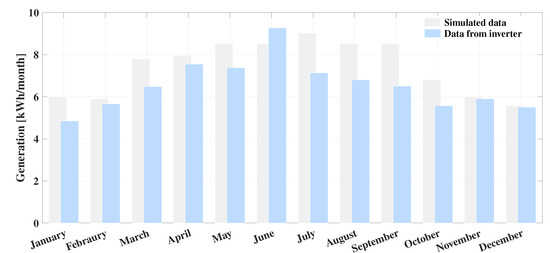
Figure 9.
Energy system generation in kWh/month.
The initial case results were contrasted with the data obtained by the solar system installed on the facade of the building. For this, the experimental BIPV solar system’s generation levels were recorded from January to December 2019 to observe the generation behavior over an entire year.
Between May and August, the highest generation levels were obtained for both simulation and real generation. Between July and September, the most significant deviation between the results obtained for energy was presented. September had the most significant deviation with , while November and December had the slightest deviations of . The average difference between simulation results and actual generation was with a standard deviation of kWh/month.
On the other hand, the peak sun hours (PSH), also known as effective sun hours, were calculated for the BIPV system. This indicator describes the amount of radiation received by the system expressed in units of time [36]. This parameter was calculated as the average daily solar generation of the system divided by its nominal capacity (Wh/Wp) [37]. For the case study, it is h of average sunshine per day. As a comparison with another solar system located in Medellin, the company AZIMUT ENERGIA S.A.S. shares the results of a 30 kWp solar generation system located at the ESSO Industriales gas pump, where it has an average monthly generation of kWh and h of average sunshine per day [38]. As a result, the BIPV system, monitored by its geographic location, the position of the panels, and incident shadows from nearby buildings, receives less effective hours of sunshine than a traditional rooftop system with the same technology.
3.4. Return on Investment
An economic analysis was carried out to evaluate the profitability of the experimental setup, considering the following factors:
- System capacity: the experimental system of 8 panels installed in the building with a generating capacity of 400 Wp.
- Cost per Wp installed: the cost of each Wp installed is USD. This cost was taken from Table 1 where the unit installation prices of different photovoltaic generation technologies were compared, both for roofs and facades. In this case, the unit price of the monocrystalline silicon technology with facade installation was chosen.
 Table 1. Characteristics of the solar system installed.
Table 1. Characteristics of the solar system installed. - Exchange rate: an average value of 3400 COP/USD (TRM of 27 January 2020) was taken due to the constant variation of the TRM in the market.
- Total CAPEX: the total cost of the project. The value is obtained from the product of the total capacity of the system, the cost per Wp installed, and the chosen exchange rate. The total CAPEX of the installation used was USD 640.
- Average generation per year: this value was obtained from the simulation stage of the BIPV system (87,600 Wh/year).
- Energy price: the value is USD/kWh. This price was obtained from energy utility bills and is influenced by socioeconomic factors and the location of the property.
A summary of the above factors is presented in Table 1. The simple time of payback was calculated as a measure of the system’s profitability. It provides the time in which the investment would be recovered according to the average energy generation per year. The evaluation yielded a payback time of years. With a payback of years, this project is not profitable because the average life of a solar system is 20 to 25 years [39]. Therefore, the analyzed BIPV system never achieves payback. Then, alternatives will be proposed to improve the project’s financial results, considering nearby buildings and geospatial location. These aspects are of great importance when designing a photovoltaic system and will allow evaluation of the project’s feasibility.
3.5. Improvements
To evaluate the influence of geographic conditions, system size, surrounding interference, and type of technologies on energy production and economic analysis, three additional cases were considered:
- Real-life geospatial conditions with BIPV and BAPV integrations.
- A 90° rotation of the coordinate axis to evaluate the impact of the sun angle through the day all year.
- Real-life geospatial conditions without the front building of the house.
For every case of study, five different simulations and some tax benefits of Law 1715 (VAT and tariff exemption) will be implemented. The type of building was defined as residential, the load on the three floors is 1 kWh/m, and the total area of the building is 159 m. The input tariff is USD/kWh, and the network tariff is USD/kWh.
4. Scenarios Results
This section presents a detailed analysis of the different scenarios, analyzing the implementation of different BIPV technologies with different power capacity increments. Converters were suggested by software that fits the needs of the projects. Commercial technology is integrated into software libraries; therefore, they were not modified in the following projects even though all study cases have the same increase in power capacity due to their geospatial and surrounding changes in power output and financial results.
4.1. Scenario 1: Real-Life Geospatial Conditions with BIPV and BAPV Integrations
For this case study, five projects were simulated. The first aspect considered was increasing the PV capacity, considering the impact of the partial shadowing on the investment ratio, energy production, and time of payback.
4.1.1. IC
As mentioned in Section 3.1, the custom installation of BIPV was simulated in the PVSITES software. The PV input implemented was manually introduced. Figure 10 shows the sun’s behavior throughout the day. Here, it is essential to emphasize that the sunrise occurs behind the house, and the sunset will be in front of the house. The yellow lines describe the sun’s position throughout the year, and the yellow ovals represent the sun’s position during the sun’s hours. The red line represents the sun’s current position, and the red oval represents the current hour of the day. As the location is close to the equator, the sun hours do not change drastically, and it is usually present from to .
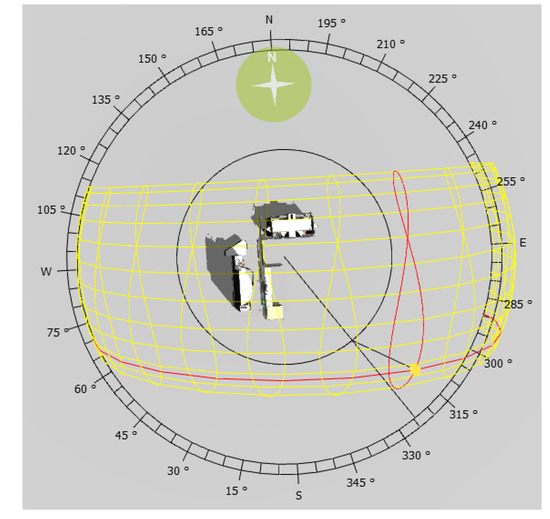
Figure 10.
Real-life geospatial conditions.
This project has the disadvantage that in the morning, the BIPV modules have no energy production, and in the afternoon, the front building shades the modules. For that reason, no positive technical and economic results are expected, but the case was practical to test the software deviation.
For this model, a Mastervolt inverter 1 kWp was selected, 1 string per MPP with a string size of 9 slots. A cable of /mm/m with a cross-sectional area of mm was used.
4.1.2. IC + UppW
This simulation was carried out by installing 11 more customized modules on the upper windows (UppW) in the initial case scenario (IC) as Figure 11 shows.
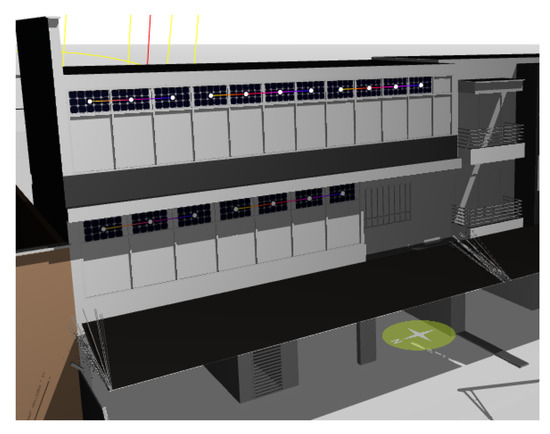
Figure 11.
Initial case + upper windows.
For this model, the software suggested working with an inverter of kWp capacity (Mastervolt). Although inverters can be manually modified, software suggestions always meet the manufacturer’s recommendations. However, inverters do not achieve high-efficiency values when they work under or over optimal conditions.
4.1.3. IC + TRA
Eighteen CIGS-adjusted translucid Sunpartner modules were selected to evaluate the performance of different BIPV technologies. Figure 12 displays the new installation with the wiring patterns. The size of each module is mm. The short circuit current is 15 A; the nominal voltage is V, and the peak power is 64 Wp.
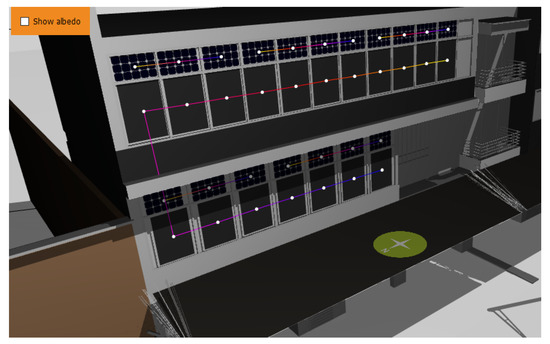
Figure 12.
Initial case + translucid modules.
In this case, the software recommended using two Aixcon Elektrotechnik inverters of kWp each.
4.1.4. IC + TRA + RF
A total of 48 modules were located on the roof with no incline to evaluate the performance of BAPV to take advantage of the sun hours. Kingfirst Solar Tech modules with 48 cells were used. The modules have a short circuit current of A, a nominal voltage of V, and a peak power of 110 Wp. Figure 13 illustrates the new BIPV and BAPV systems.
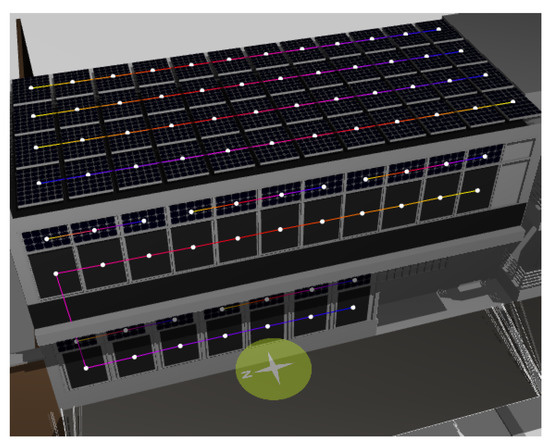
Figure 13.
Initial case + translucid + RoofFlat.
In the morning, the BIPV modules do not generate power. Then, the roof modules take advantage of the sun in the morning and midday. Flat modules require a Mastervolt inverter of kWp, 2 strings per MPP, and a string size of 12 slots.
4.1.5. IC + TRA + RA
A total of 45 modules were installed instead of 48 to evaluate the effect of the angle of incline of BAPV modules. The orientation changed 90°, and the incline was established at 30°, looking toward the back of the house as Figure 14 shows. In this case, the software suggested a Trace Engineering inverter of 5 kWp with 15 strings per MPP and a string size of 3 slots.
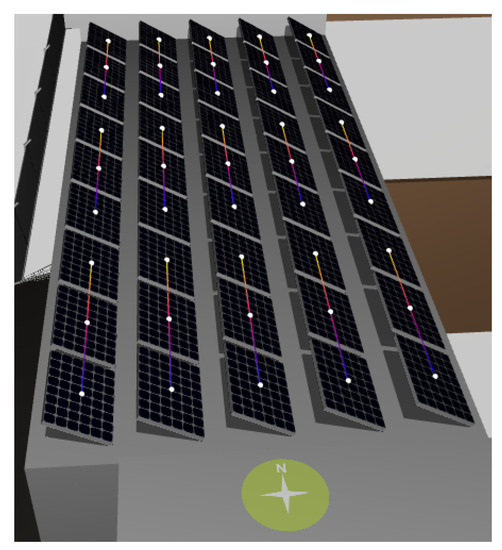
Figure 14.
Initial case + translucid + RoofAngle.
4.1.6. Results
Table 2 summarizes the results obtained from the simulated models:

Table 2.
Real-life geospatial conditions with BIPV and BAPV integrations.
The BIPV projects are not feasible due to their long periods of payback. However, as the installed capacity increases, the investment rate decreases in the software. In general, the location of the system makes the BIPV option unattractive.
On the other hand, integrating the BIPV project with BAPV technologies decreases the time of payback values. In the last BAPV model, although the “IC + TRA + RF” model has the best performance, the “IC + TRA + RA” has less installed capacity and less total expenditure (TOTEX) due to the angle of incline.
4.2. Scenario 2: 90° Rotation of the Coordinate Axis
Rotating the axis project allows for evaluating the impact of the shadows and the sun on the projects from different angles throughout the year. Furthermore, BIPV and BAPV would behave differently than in the last case study. Figure 15 shows the new orientation of the case study.
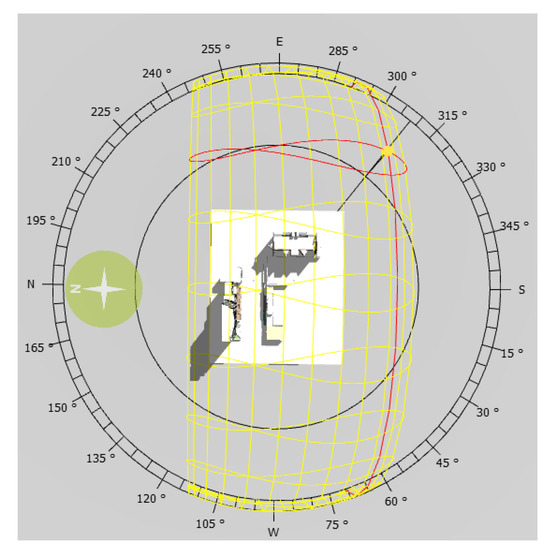
Figure 15.
A 90° rotation of the coordinate axis.
In this case, the north is in front of the house and the sun rises from the right side of the house. Table 3 shows a summary of the results of all the cases with the new orientation.

Table 3.
A 90° rotation of the coordinate axis.
Since the models are the same for the three scenarios, the first three rows of the table remain the same as in Table 2. Similar to the last case study, the best relationship between technical and economic values was obtained with the projects integrated with BAPV. However, one disadvantage of the software is clearly seen. As the installed photovoltaic capacity increases and the load is fed, the losses also increase. Unfortunately, PVSITES could not work with storage devices, which could negatively impact the simulated projects, even causing a reduction in the payback values.
4.3. Scenario 3: Real-Life Geospatial Conditions without the Front Building of the House
The front building is a drawback in the performance of Case Study 1. Therefore, a modification was proposed: the building is changed to a three-floor house; it eliminates the front shading of the house during the afternoon.
Table 4 presents the results of the simulation.

Table 4.
Real-life geospatial conditions with BIPV and BAPV integrations without front building.
This case presents the best results. The installed capacity is the same, but the payback values are lower than the ones obtained with the other projects. In addition, energy production and efficiency were also higher.
This particular scenario is the most attractive with regard to the sun’s direct influence in every simulated module. Therefore, the self-consumed capacity was the highest of all these three scenarios.
5. Discussion
The purpose of this paper was to clearly address the key factors for designing an efficient BIPV and BAPV systems from a real-life scenario to plausible simulated cost-efficient solutions. Following the methodology described in Section 2, it was also possible to contrast the total energy production of the installed project through its simulation where the software deviation was estimated. Based on it, the holistic improvement of the installed BIPV was then carried out.
Based on the initial scenario, it was possible to achieve a payback period less than the project’s lifetime when the installed capacity was increased by 18 times, maximizing the installation area, for which it was necessary to use the entire area of the front windows and the available roof area. For all three scenarios, the best result was presented by the IC + TRA + RF. However, decreasing the installed capacity as in IC + TRA + RA does not have a considerable loss in the production rate and provides better savings in technical and economic balance of around USD . By properly adjusting the module locations to the solar azimuth, economic savings up to could be achieved as shown in the different scenarios.
The most critical design aspects are its elevated costs, available area, solar azimuth, and the potential shadows due to surrounding structures. This paper showed how such aspects must be considered to improve BIPV performance.
6. Conclusions
- Both the area (installed capacity) and the irradiance conditions (partial shading) were identified as the most relevant factors in the design of a BIPV system. These factors were not considered in the design stage of the real system, which is reflected in the payback, which exceeds the lifetime of the elements that make up the PV system.
- Several factors directly impact BIPV and BAPV projects. In the cases presented in this work, using only BIPV technologies is not attractive for payback values. Office buildings or houses with significant numbers of windows integrated with BIPV would not generate as much needed power as roof installations.
- PVSITES is flexible, sizing the desired PV modules to use in a project. It also contains a large library of technologies to install on a project, giving the software an advantage over others available. This tool is definitely a complete tool to simulate BIPV and BAPV projects.
- As future work, an additional planning stage could consider including aspects, such as energy storage and connection to the grid.
- The construction of photovoltaic panels of specific measurements was identified as an interesting area to strengthen the development of BIPV systems. In the same way, it is important to propose clear methodologies for the planning and design of BIPV systems which allow making the best technical and economic decisions. Finally, more reductions in taxes or other governmental programs that incentivize the use of renewable energy are needed. This could attract more investment and therefore more development for the BIPV market.
Author Contributions
Conceptualization, B.J.R.-C. and L.A.T.-G.; methodology, D.R.-H., and B.J.R.-C.; simulation, D.R.-H. and W.M.; validation, D.R.-H. and W.M.; formal analysis, D.R.-H.,W.M., B.J.R.-C. and L.A.T.-G.; writing—original draft preparation, D.R.-H.,W.M., B.J.R.-C. and L.A.T.-G.; writing—review and editing, D.R.-H., B.J.R.-C. and L.A.T.-G.; All authors have read and agreed to the published version of the manuscript.
Funding
The APC was funded by the Instituto Tecnológico Metropolitano (Dirección de investigaciones).
Conflicts of Interest
The authors declare no conflict of interest.
Abbreviations
The following abbreviations are used in this manuscript:
| a-Si | Amorphous Silicon |
| BAPV | Building Applied Photovoltaics |
| BIPV | Building-integrated photovoltaics |
| BIPVT | Building-integrated photovoltaics-thermal |
| CAD | Computer-aided design |
| CAPEX | Capital Expenditures |
| CdTe | Cadmium telluride |
| CIGS | Copper indium gallium diselenide |
| CIS | Copper indium sulfide |
| DSF | Double-skin facade |
| GHI | Global Horizontal Irradiation |
| IC | Initial case |
| MPPT | Maximum Power Point Tracker |
| NREL | National Renewable Energy Laboratory |
| NZEB | Net Zero Energy Buildings |
| OPEX | Operational Expenditures |
| PSH | Peak Sun Hours |
| PV | Photovoltaic |
| RF | Roof flat |
| TF | Thin-film |
| TOTEX | Total expenditures |
| TRA | Translucid modules |
| TRM | Technical Reference Model |
| UppW | Upper Windows |
| VAT | Value-Added Tax |
| WB | Without Front Building |
| WTs | Wind Turbines |
References
- Efurosibina Attoye, D.; Tabet Aoul, K.; Hassan, A. Mandatory Policy, Innovations and the Renewable Energy Debate: A Case Study on Building Integrated Photovoltaics. Buildings 2022, 12, 931. [Google Scholar] [CrossRef]
- Chen, T.; An, Y.; Kiang Heng, C. A Review of Building-Integrated Photovoltaics in Singapore: Status, Barriers, and Prospects. Sustainanility 2022, 14, 10160. [Google Scholar] [CrossRef]
- International Renewable Energy Agency. Renewable Power Generation Costs in 2021; Technical Report; International Renewable Energy Agency: Abu Dhabi, United Arab Emirates, 2022. [Google Scholar]
- REN 21. Renewables 2020 Global Status Report; REN21 Secretariat: Paris, France, 2020; pp. 120–130. Available online: https://www.ren21.net/wp-content/uploads/2019/05/gsr_2020_full_report_en.pdf (accessed on 1 September 2022)ISBN 978-3-948393-00-7.
- REN 21. Renewables 2019 Global Status Report; REN21 Secretariat: Paris, France, 2019; ISBN 978-3-9818911-7-1. Available online: https://www.ren21.net/wp-content/uploads/2019/05/gsr_2019_full_report_en.pdf (accessed on 15 August 2022).
- Jäger-Waldau, A. Snapshot of photovoltaics—February 2020. Energies 2020, 13, 930. [Google Scholar] [CrossRef]
- Martín-Chivelet, N.; Kapsis, K.; Rose Wilson, H.; Delisle, V.; Yang, R.; Olivieri, L.; Polo, J.; Eisenlohr, J.; Roy, B.; Maturi, L.; et al. Building-Integrated Photovoltaic (BIPV) products and systems: A review of energy-related behavior. Energy Build. 2022, 262, 111998. [Google Scholar] [CrossRef]
- Pagliaro, M.; Ciriminna, R.; Palmisano, G. BIPV: Merging the photovoltaic with the construction industry. Prog. Photovolt. Res. Appl. 2010, 18, 61–72. [Google Scholar] [CrossRef]
- Verberne, G.; Bonomo, P.; Frontini, F.; Van Den Donker, M.; Chatzipanagi, A.; Sinapis, K.; Folkerts, W. BIPV products for facades and roofs: A market analysis. In Proceedings of the 29th European Photovoltaic Solar Energy Conference and Exhibition, Amsterdam, The Netherlands, 22–26 September 2014; pp. 3630–3636. [Google Scholar]
- Shukla, A.K.; Sudhakar, K.; Baredar, P. Recent advancement in BIPV product technologies: A review. Energy Build. 2017, 140, 188–195. [Google Scholar] [CrossRef]
- Tripathy, M.; Sadhu, P.; Panda, S. A critical review on building integrated photovoltaic products and their applications. Renew. Sustain. Energy Rev. 2016, 61, 451–465. [Google Scholar] [CrossRef]
- Members of the PVSITES Consortium. BIPV Market and Stakeholder Analysis and Needs. 2016. Available online: https://www.pvsites.eu/downloads/download/report-bipv-market-and-stakeholder-analysis-and-ne (accessed on 7 September 2022).
- IDEAM. Atlas de Radiaciǿn Solar, Ultravioleta y Ozono de Colombia. 2015. Available online: https://www.atlas.ideam.gov.co/visorAtlasRadiacion.html (accessed on 8 October 2022).
- Ministerio de Minas y Energía. Energías Renovables No Convencionales. 2015. Available online: https://www.minenergia.gov.co/energias-renovables-no-convencionales (accessed on 13 September 2022).
- Fathi, M.; Aissat, A.; Ayad, M. Design of Building Integrated Photovoltaic (BIPV) and integration of photons converters. Energy Procedia 2012, 18, 377–383. [Google Scholar] [CrossRef]
- Khan, M.; Zeb, K.; Uddin, W.; Sathishkumar, P.; Umair Ali, M.; Hussain, S.; Ishfaq, M.; Himanshu; Subramanian, A. Design of a Building-Integrated Photovoltaic System with a Novel Bi-Reflector PV System (BRPVS) and Optimal Control Mechanism: An Experimental Study. Electronics 2018, 7, 119. [Google Scholar] [CrossRef]
- Lovati, M.; Salvalai, G.; Fratus, G.; Maturi, L.; Albatici, R.; Moser, D. New method for the early design of BIPV with electric storage: A case study in northern Italy. Sustain. Cities Soc. 2019, 48, 101400. [Google Scholar] [CrossRef]
- Singh, D.; Akram, S.V.; Singh, R.; Gehlot, A.; Buddhi, D.; Priyadarshi, N.; Sharma, G.; Bokoro, P. Building Integrated Photovoltaics 4.0: Digitization of the Photovoltaic Integration in Buildings for a Resilient Infra at Large Scale. Electronics 2022, 11, 2700. [Google Scholar] [CrossRef]
- Rababah, H.; Ghazali, A.; Mohd Isa, M. Building Integrated Photovoltaic (BIPV) in Southeast Asian Countries: Review of Effects and Challenges. Sustainability 2021, 13, 12952. [Google Scholar] [CrossRef]
- Ahmed-Dahmane, M.; Malek, A.; Zitoun, T. Design and analysis of a BIPV/T system with two applications controlled by an air handling unit. Energy Convers. Manag. 2018, 175, 49–66. [Google Scholar] [CrossRef]
- Abdalgadir, Y.; Qian, H.; Zhao, D.; Adam, A.; Liang, W. Daily and annual performance analyses of the BIPV/T system in typical cities of Sudan. Energy Built Environ. 2022. [Google Scholar] [CrossRef]
- Abdelrazik, A.S.; Shboul, B.; Elwardany, M.; Zohny, R.N.; Osama, A. The recent advancements in the building integrated photovoltaic/thermal (BIPV/T) systems: An updated review. Renew. Sustain. Energy Rev. 2022, 170, 112988. [Google Scholar] [CrossRef]
- Robinson, D.; Stone, A. Irradiation modelling made simple: The cumulative sky approach and its applications. In Proceedings of the PLEA Conference, Eindhoven, The Netherlands, 19–21 September 2004; pp. 19–22. [Google Scholar]
- Compagnon, R.; Raydan, D. Irradiance and illuminance distributions in urban areas. In Proceedings of the PLEA, Cambridge, UK, 2–5 July 2000; pp. 436–441. [Google Scholar]
- Marion, B.; Anderberg, M.; Gray-Hann, P.; Heimiller, D. PVWATTS Version 2–Enhanced Spatial Resolution for Calculating Grid-Connected PV Performance; Technical Report; National Renewable Energy Laboratory: Golden, CO, USA, 2001. [Google Scholar]
- Kim, D.W.; Park, C.S. Difficulties and limitations in performance simulation of a double skin façade with EnergyPlus. Energy Build. 2011, 43, 3635–3645. [Google Scholar] [CrossRef]
- Calise, F.; Cappiello, F.L.; d’Accadia, M.D.; Vicidomini, M. Dynamic simulation, energy and economic comparison between BIPV and BIPVT collectors coupled with micro-wind turbines. Energy 2020, 191, 116439. [Google Scholar] [CrossRef]
- Jakica, N. State-of-the-art review of solar design tools and methods for assessing daylighting and solar potential for building-integrated photovoltaics. Renew. Sustain. Energy Rev. 2018, 81, 1296–1328. [Google Scholar] [CrossRef]
- International Energy Agency. BIPV Design and Performance Modelling: Tools and Methods; Technical Report; International Energy Agency: Paris, France, 2019. [Google Scholar]
- Martínez Gómez, W.F. Metodología de Diseño, Montaje y Evaluación de Sistemas Fotovoltaicos Integrados a la Estructura de Edificaciones; Maestría en Gestión Energética Industrial; Instituto Tecnológico Metropolitano: Medellín, Colombia, 2020. [Google Scholar]
- PVSITES. Software and Catalogues. 2022. Available online: https://www.pvsites.eu/software/ (accessed on 5 November 2022).
- Members of the PVSITES Consortium. D7.2 Second Prototype of BIPV Simulation Tool. Technical Report; PVSITES: 2016. Available online: https://ec.europa.eu/research/participants/documents/downloadPublic?documentIds=080166e5af1fd17d&appId=PPGMS (accessed on 3 July 2022).
- EPM. Tarifas, Solicitud del Servicio, Usos Inteligente del Servicio Público de Generación, Transmisión y Distribución de Energía y Electricidad de EPM por Parte de Usuarios de Hogares. 2019. Available online: https://www.epm.com.co/site/clientesusuarios/clientesyusuarios/empresas/energia/grandesempresas/tipsparaelusointeligente (accessed on 3 October 2022).
- EPM. Empresa de Servicios Públicos de Medellín y Colombia. 2019. Available online: https://www.epm.com.co/site/ (accessed on 23 June 2022).
- UPME. Calculadora de Emisiones CO2. 2021. Available online: http://www.upme.gov.co/calculadora_emisiones/aplicacion/calculadora.html (accessed on 27 June 2022).
- Guerra Posada, F. Manual Para Personas Interesadas en ser Prosumidores de Energía a Partir de Paneles Solares en Colombia; Facultad de Ingenierías, Universidad EIA: Envigado, Colombia, 2017; Available online: https://repository.eia.edu.co/handle/11190/1848 (accessed on 15 September 2022).
- Lindao Suárez, W.E. Propuesta de Diseño de un Sistema de Energía Solar Fotovoltaica. Caso de Aplicación en Casa Comunal de Cooperativa Los Paracaidistas en la Ciudad de Guayaquil; Facultad de Ingenierías, Universidad Católica de Santiago de Guayaquil: Guayaquil, Ecuador, 2020; Available online: http://repositorio.ucsg.edu.ec/handle/3317/14365 (accessed on 30 September 2022).
- Azimut. Reporte de Generación. 2019. Available online: https://www.azimutenergia.co/casos-de-exito/ (accessed on 3 March 2022).
- DamiaSolar. Cuál es la Vida úTil de los Paneles Solares. 2021. Available online: https://www.damiasolar.com/actualidad/blog/articulos-sobre-la-energia-solar-y-sus-componentes/cual-es-la-vida-util-de-los-paneles-solares_1 (accessed on 3 June 2022).
Disclaimer/Publisher’s Note: The statements, opinions and data contained in all publications are solely those of the individual author(s) and contributor(s) and not of MDPI and/or the editor(s). MDPI and/or the editor(s) disclaim responsibility for any injury to people or property resulting from any ideas, methods, instructions or products referred to in the content. |
© 2023 by the authors. Licensee MDPI, Basel, Switzerland. This article is an open access article distributed under the terms and conditions of the Creative Commons Attribution (CC BY) license (https://creativecommons.org/licenses/by/4.0/).